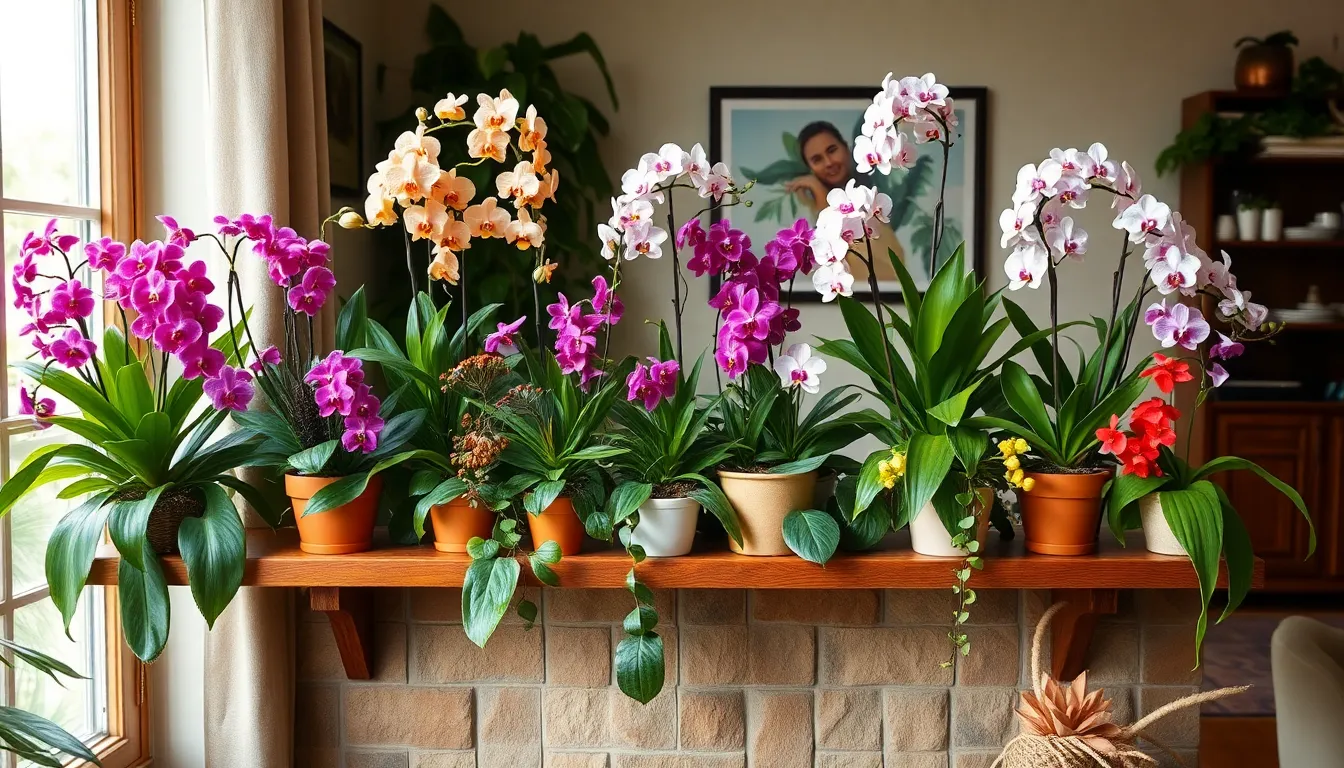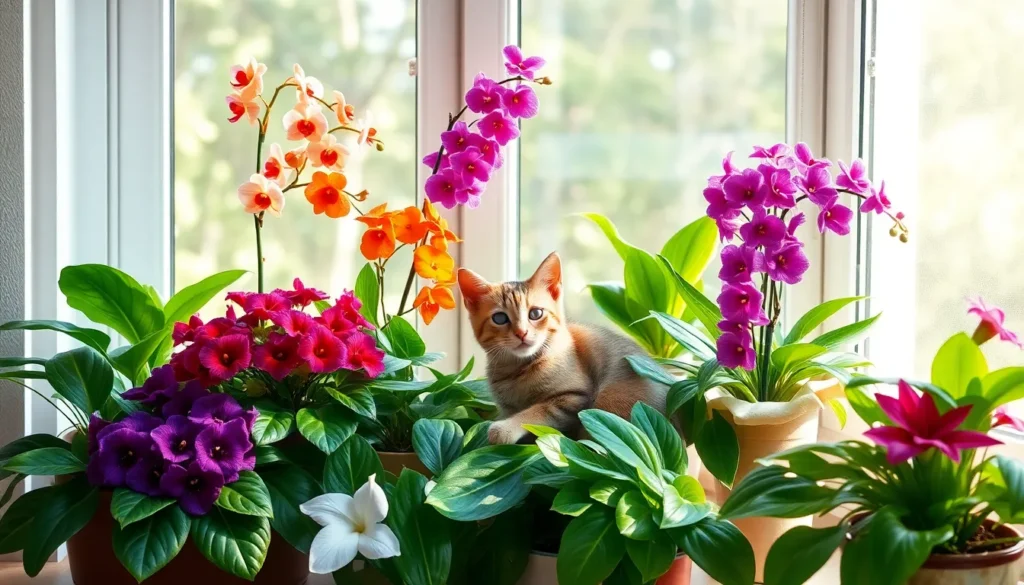Table of Contents
ToggleImagine transforming your living space into a vibrant oasis with just a few flowering house plants. These botanical beauties not only brighten up any room but also bring a splash of color and life that can make even the grumpiest cat smile. Who knew that a little greenery could have such a profound effect on mood and ambiance?
Overview of Flowering House Plants
Flowering house plants serve as vibrant additions to indoor spaces. These plants often display colorful blooms that enhance aesthetic appeal. Popular choices include African violets, orchids, and peace lilies, each providing unique characteristics and care requirements.
Care for flowering house plants typically involves optimal sunlight, proper watering, and suitable soil conditions. African violets thrive in indirect light, while orchids often prefer brighter settings. Similarly, peace lilies flourish in low light but still produce stunning white flowers that brighten dark corners.
Watering schedules vary. African violets benefit from consistent moisture, avoiding overwatering to prevent root rot. Orchids require less frequent watering, generally every week or two, allowing the potting medium to dry out between waterings. Peace lilies, however, signal a need for water by drooping slightly, making it easy to gauge hydration levels.
Fertilization plays a critical role in encouraging blooms. A balanced, water-soluble fertilizer used every four to six weeks typically works well. This practice boosts growth and flowering, resulting in more vibrant displays.
Health considerations for flowering house plants include watchfulness for pests such as aphids and spider mites. Regular inspections help identify problems early, promoting better plant health. Utilizing insecticidal soap can resolve pest issues effectively.
In essence, flowering house plants enrich living spaces, combining beauty with benefits. Each plant offers distinct visual appeal and care needs, contributing to a lively indoor atmosphere while promoting well-being.
Benefits of Flowering House Plants

Flowering house plants provide numerous advantages, enhancing both the living environment and personal well-being.
Aesthetic Appeal
Colorful blooms bring vibrancy to indoor spaces. They create a welcoming atmosphere that elevates mood and complements decor. People often find that playful arrangements of flowering plants serve as natural focal points. Some popular varieties, like orchids and African violets, showcase exquisite colors and shapes, adding visual interest. Displays can vary from minimalist to lush, tailored to individual preferences and styles. Not only do these plants beautify homes, but they also promote creativity and positivity in shared spaces.
Air Quality Improvement
Flowering house plants contribute to better indoor air quality. Research indicates that certain plants absorb pollutants and release oxygen, fostering a healthier living space. Peace lilies, for instance, effectively filter harmful substances like formaldehyde and benzene. Increased oxygen levels can enhance concentration and energy. Regularly caring for these plants often encourages mindfulness, further enhancing their health benefits. Investing in flowering house plants promotes a balance between aesthetics and well-being, yielding a refreshing atmosphere.
Popular Types of Flowering House Plants
Flowering house plants bring beauty and liveliness indoors. Here are some popular options:
African Violets
African violets stand out with their stunning blooms in various colors. These plants thrive in indirect light, making them ideal for many indoor spaces. Consistent moisture is essential for their growth. Proper watering involves keeping the soil slightly moist but never soggy. Fertilizing every few weeks during the growing season encourages abundant flowers. They also prefer humidity, making them great bathroom or kitchen companions.
Peace Lilies
Peace lilies offer elegant white blooms and lush green leaves. They thrive in low light, perfect for darker rooms where other plants may struggle. Watering them requires attention; the leaves droop slightly when they need water. This natural signal helps owners care for them properly. Fertilization should occur every few months to promote flowering. Peace lilies also improve air quality by filtering toxins, enhancing the indoor environment.
Orchids
Orchids are known for their exotic flowers and diverse varieties. These plants flourish in bright, indirect light, ensuring they display their spectacular blooms. Less frequent watering suits orchids; allowing the substrate to dry out between waterings is crucial. Fertilizing every few weeks can aid in promoting beautiful flowers. Certain orchids like phalaenopsis remain popular for their longevity and ease of care, making them excellent choices for both novice and experienced plant owners.
Care Tips for Flowering House Plants
Proper care ensures flowering house plants thrive and flourish. Each species comes with specific requirements, making attention to detail crucial.
Light Requirements
Flowering house plants need adequate light for optimal growth. African violets prefer bright, indirect light, while orchids thrive in bright settings too but don’t tolerate direct sun. Peace lilies do well in low light, making them adaptable for various spaces. Positioning plants near windows increases access to natural light, but filtering direct rays helps prevent leaf burn. Regularly checking plant behavior can indicate if light levels need adjustment.
Watering Guidelines
Watering habits differ among flowering house plants. African violets like consistent moisture in their soil but don’t do well in soggy conditions. Orchids require less frequent watering, typically every two weeks, allowing the substrate to dry out between sessions. Peace lilies signal their needs through drooping leaves, so checking soil moisture is essential. Always use pots with drainage holes to prevent root rot and promote healthy growth.
Fertilizing Techniques
Fertilization keep flowering house plants healthy and encourages vibrant blooms. A balanced liquid fertilizer every four to six weeks supports the growth of African violets and orchids. Peace lilies benefit from a diluted houseplant fertilizer every eight weeks. Applying fertilizers during the growing season, from spring to fall, provides necessary nutrients. Monitoring for signs of nutrient deficiency, like yellowing leaves, helps adjust fertilization schedules accordingly.
Challenges and Solutions
Flowering house plants face specific challenges that can affect their health and beauty. Addressing these issues keeps plants flourishing and vibrant.
Common Pests
Aphids and spider mites frequently attack flowering house plants. These pests often thrive in indoor environments, particularly when plants are stressed. Regular inspections help identify infestations early. Insecticidal soap effectively eliminates pests without harming the plants. Neem oil offers another option, providing both prevention and treatment. Keeping plants healthy by maintaining ideal care conditions helps reduce pest problems. Increasing humidity can also deter pests, as many prefer dry environments.
Disease Prevention
Fungal infections and root rot frequently threaten flowering house plants. Overwatering typically causes these issues, so monitoring soil moisture levels is essential. Providing adequate air circulation helps prevent fungal diseases as well. Using sterilized pots and fresh soil when repotting can minimize the risk of contamination. Additionally, removing dead leaves and spent blooms reduces disease spread. Applying a balanced fertilizer supports healthy growth, making plants more resilient to diseases. Regularly inspecting plants for early signs of trouble enables timely intervention.
Flowering house plants bring a unique blend of beauty and health benefits to any indoor space. Their vibrant blooms not only enhance decor but also uplift moods and create a welcoming atmosphere. With the right care and attention, these plants can thrive and provide endless joy.
Choosing the right variety for specific lighting conditions and understanding their watering needs is crucial for success. By fostering a mindful approach to plant care, individuals can enjoy the therapeutic effects of nurturing these green companions.
Ultimately, incorporating flowering house plants into living spaces enriches the environment while promoting well-being and tranquility.







